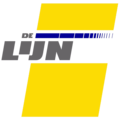De Lijn
 | |
 | |
| Parent | Flemish Government |
|---|---|
| Founded | 1991 |
| Headquarters | Mechelen |
| Service area | Flemish Region |
| Service type | bus service, tram, demand responsive transport |
| Website | www.delijn.be |

Vlaamse Vervoersmaatschappij De Lijn[1] (Template:Lang-en), usually known as De Lijn ("The Line"), is a company run by the Flemish government in Belgium to provide public transportation with about 3650 buses and 359 trams. De Lijn was founded in 1991 after the public transportation companies of Antwerp and Ghent fused with the Flemish part of the NMVB (Nationale Maatschappij van Buurtspoorwegen, or the "National Company of Neighborhood Railways").
Socialist politician Steve Stevaert of Hasselt implemented a policy allowing registered residents in Flanders aged 65+ to ride anywhere in Flanders free. Other incentives exist for people under age 25. De Lijn is being viewed as an integral part to reduce heavily congested traffic, together with the NMBS (Belgium's national rail operator).
In 2008, it transported more than 508 million passengers in an area with a population of approximately 6.5 million.
De Lijn operates:
- Antwerp Tramway, with both street running and underground light rail (Antwerp Pre-metro).
- Ghent Tramway, mostly street running with some reserved track.
- Belgian coast tram, interurban line along the whole Belgian coast, between De Panne and Knokke.
- All urban, suburban and intercity buses in Flanders. Because of the dense rail network, intercity buses serve as local transport between big cities and smaller communities. Time to travel from one city to another by bus is most often longer than for the same journey on the train because bus lines are less straight, as they pass through many small towns that are not served by railway. The buses are more city-style (no coach buses are used). In the Limburg province with few railways buses are the main mode of intercity travel. There are also express intercity buses there.
- Demand responsive bus (belbus, "bus on call") in regions with low population density.
The fares are the same on all modes.
References
- ^ "De Lijn Disclaimer" (in Dutch). De Lijn. 2010. Retrieved March 4, 2011.
See also
External links
![]() Media related to De Lijn at Wikimedia Commons
Media related to De Lijn at Wikimedia Commons

